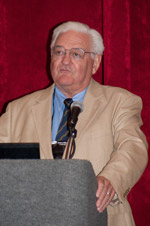Opening Session
Impact of Bos indicus Genetics on the Beef Industry
by Troy Smith for Angus Productions Inc.
HOUSTON, Texas (April 19, 2012) — Could it be that Bos indicus cattle have been unfairly characterized as less productive than their Bos taurus cousins? According to veteran research geneticist Larry Cundiff, there is ample data showing Bos indicus breeds — with their loose skin, big ears and prominent shoulder humps — have their useful place in the U.S. beef industry. And contrary to popular opinion, he thinks indicus influence can be useful in regions beyond the hot and humid South.

Larry Cundiff
Cundiff was the leadoff speaker April 18 at the 2012 Beef Improvement Federation (BIF) Research Symposium in Houston, Texas. The former director for the Roman L. Hruska U.S. Meat Animal Research Center (USMARC) talked about USMARC’s Germplasm Evaluation Project. The long-running series of experiments, which began in the 1970s, has evaluated 37 breeds of cattle, including several Bos indicus breeds.
According to Cundiff, the performance of about 200 progeny per sire breed has been evaluated during each of the project’s seven two- to three-year cycles. F1-cross females, including cows representing various taurus-indicus crosses, were evaluated through seven years of age. Traits important to beef production and lifetime reproduction were scrutinized for cattle maintained at USMARC’s Clay Center, Neb., site, but their performance also was compared with cattle maintained under different environmental conditions in Florida and Louisiana.
Even at the Nebraska location, explained Cundiff, cows with indicus influence demonstrated efficiency. During cold, wet spring-calving periods, however, calf mortality increased significantly among calves of 50% or greater indicus genetics. Postweaning performance was significantly lower, during winter months, for calves with greater than 25% indicus blood.
Additionally, increasing indicus influence was associated with a decrease in beef tenderness, as measured by shear force test. Cundiff said experiments suggest each 25% increase in indicus blood adds about one and a half pounds of shear force.
Cundiff said it’s “pretty obvious” cattle with greater indicus influence are most adapted to hotter, humid climates. Along the Gulf Coast, for example, 50% indicus influence may be optimal. South of there, in harsher tropical climates, 75% could be even better. However, Cundiff believes the evidence indicates that cattle of up to 25% indicus blood are adapted to northern regions of the United States.
“Cattle with 25% tropically adapted germplasm are suited to the intermediate subtropics, and that area extends clear into Canada. I think we sometimes forget that,” Cundiff said.
USMARC research shows that F1 females representing an indicus-taurus cross excel in efficiency and productivity, as measured by weaning weight per cow exposed to breeding. Having a lot to do with that, Cundiff said, is the significant heterosis effects present in the indicus-taurus cross. The tradeoffs, he admitted, are older age at puberty, lower winter feeding performance and lower beef tenderness.
“To deal with that,” Cundiff stated, “it makes sense to do some terminal crossing. There is a role for Bos indicus, not only globally, but in a larger portion of the United States than most of us may have thought.”
Return to the Newsroom for links to the PowerPoint presentation that accompanied this presentation.
Editor’s Note: This summary was written under contract or by staff of Angus Productions Inc. (API). Through an agreement with the Beef Improvement Federation, we are encouraging reprinting of the articles to those who will adhere to the reprint guidelines available on this site. Please review those guidelines or contact Shauna Rose Hermel, editor, at 816-383-5270. PowerPoints are posted with permission of the presenter and may not be reproduced in whole or in part without the express permission of the presenter.
API's coverage of the event is made possible through collaboration with BIF and sponsorship of LiveAuctions.tv. For questions about this site, or to notify us of broken links, click here.
Headquartered in Saint Joseph, Mo., API publishes the Angus Journal, the Angus Beef Bulletin, the Angus Beef Bulletin EXTRA, and the Angus e-List, as well as providing online coverage of events and topics pertinent to cattlemen through the API Virtual Library.



